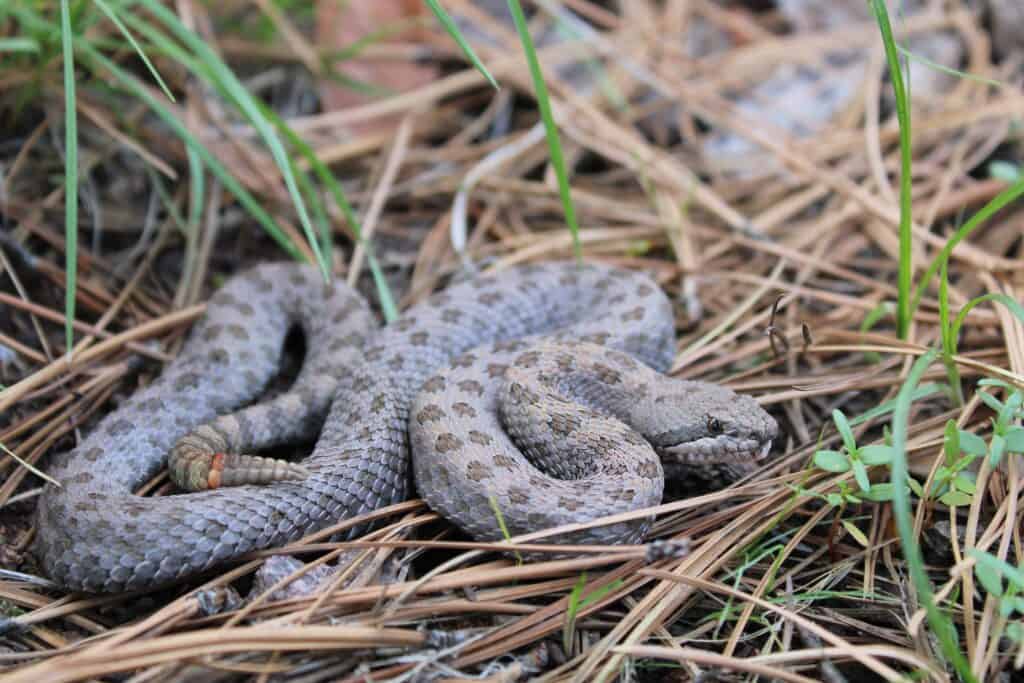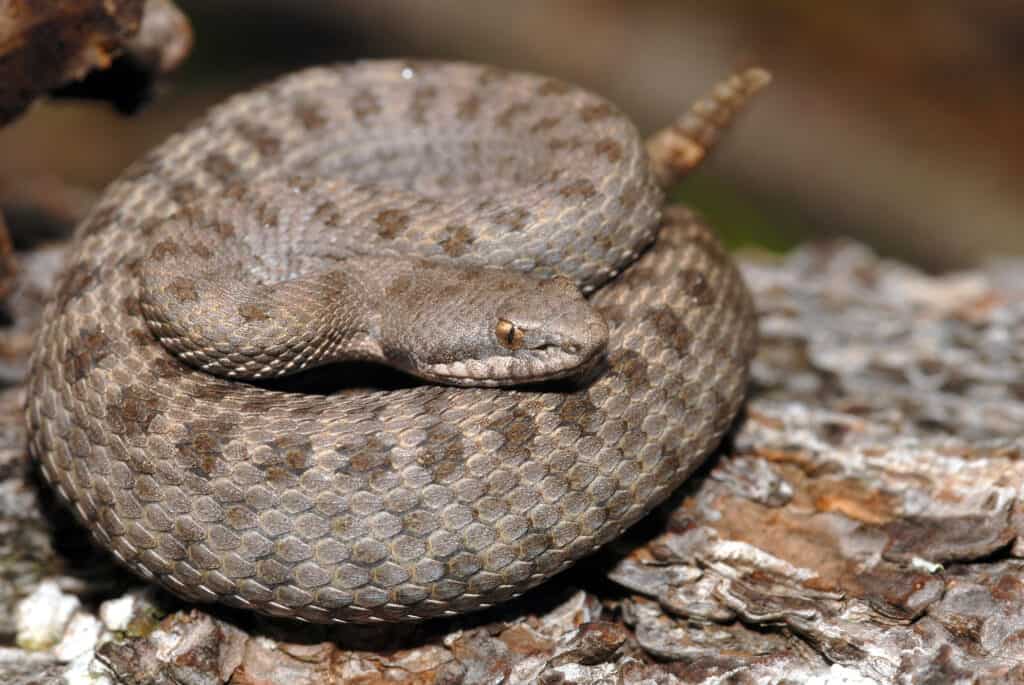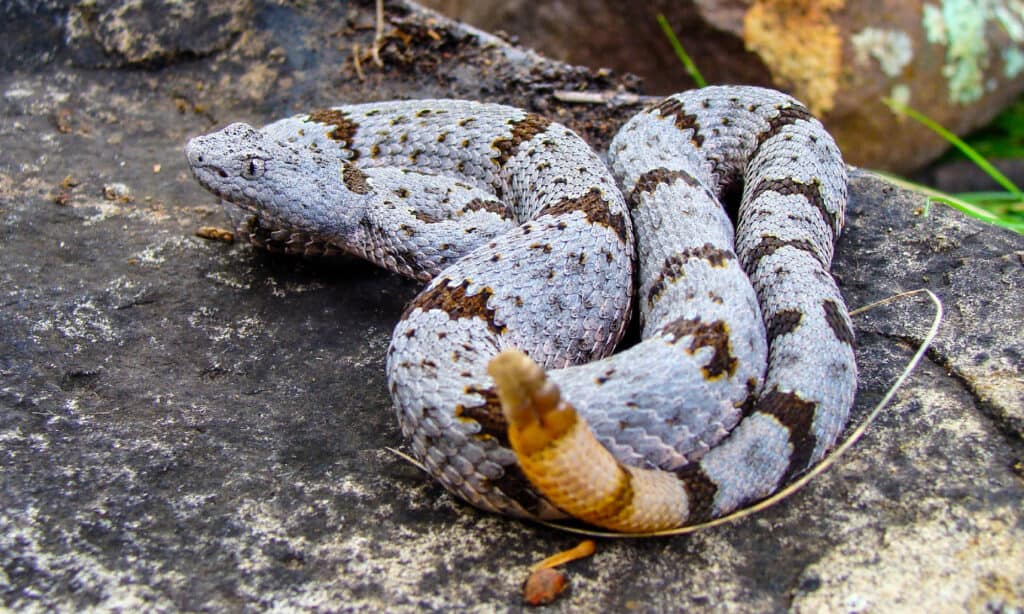Key Facts
- Twin-spotted rattlesnakes are named for the double rows of spots on their backs.
- They generally measure up to 18 inches although some may grow to 24 inches.
- There are two subspecies of these reptiles, eastern twin-spotted rattlesnakes (Crotalus pricei miquihauanus), and western twin-spotted rattlesnakes (Crotalus pricei pricei).
One of the most distinct-looking rattlesnakes out there is the twin-spotted rattlesnake (Crotalus pricei). It is hard to mistake this beautiful rattlesnake for any other snake species, due to the double rows of namesake spots on its back. Unlike some of the more iconic rattlesnakes you may see in Hollywood productions, twin-spotted rattlesnakes are smaller snakes with somewhat slender bodies. But just how big can they get? Let’s take a closer look at these unique rattlesnakes and discover the largest twin-spotted rattlesnake ever recorded!
What Do Twin-Spotted Rattlesnakes Look Like?

The twin-spotted rattlesnake is named for the distinctive rows of spots down its body
©iStock.com/adogslifephoto
The colors and patterns of twin-spotted rattlesnakes help them to blend into their surrounding environment. These snakes are usually brown, reddish-brown, tan, gray, blueish-gray, brownish-gray, or even greenish-grey in color, with rough, keeled scales, and delicate brown speckling. They get their name from the distinct blotched patterns on their backs. These two parallel rows of darker “twin spots” run down the length of their bodies. They also have two distinct dark lines that run from each eye to the back of the jaw. Their bellies are a creamy color with dark gray and brown mottling.
Twin-spotted rattlesnakes are smaller than most other rattlesnake species and their bodies are more slender. However, they are still dangerous pit vipers with wide, triangular-shaped heads and hollow, retractable fangs for injecting venom into their prey. Like other pit vipers, twin-spotted rattlesnakes use heat-sensing pit organs to locate prey and to keep an eye on potential predators. These two small “pits” are located on the snake’s face, between its eyes and nostrils.
Like all rattlesnakes, twin-spotted rattlesnakes also have segments made of keratin at the end of their tails that form a “rattle”. When the snake vibrates its tail, these segments crash against one another to make the iconic “rattling” sound. However, since twin-spotted rattlesnakes are a bit smaller when they rattle their tails, it often sounds like a loudly buzzing insect.
What is the Largest Twin-Spotted Rattlesnake Ever Recorded?

Twin-spotted rattlesnakes are not as big as many other rattlesnake species. They usually grow between 20-24 inches long, although many are only 18 inches long on average. The largest twin-spotted rattlesnake ever recorded, however, grew to 26 inches in length.
In contrast, the pygmy rattlesnake—the smallest rattlesnake in the world—grows between 15-23 inches, while the largest rattlesnake in the world—the eastern diamondback rattlesnake—has been recorded at lengths up to 7.9 feet!
Where Do Twin-Spotted Rattlesnakes Live?

Twin-spotted rattlesnakes prefer desert and mountainous regions at elevations from 6,000 – 10,000 feet.
©Tucker Heptinstall/Shutterstock.com
There are two subspecies of the twin-spotted rattlesnake: the eastern twin-spotted rattlesnake (Crotalus pricei miquihauanus), and the western twin-spotted rattlesnake (Crotalus pricei pricei). Both subspecies have a very similar appearance, although they live in different regions.
The eastern twin-spotted rattlesnake is endemic to Mexico and lives in Tamaulipas, Nuevo León, and southeastern Coahuila. The western twin-spotted rattlesnake, on the other hand, is endemic to Mexico and Arizona. In Mexico, this snake lives in Durango, Chihuahua, and Sonora. It has special protection in Arizona, and it can only be found in four isolated mountains in the southeastern regions of the state.
Twin-spotted rattlesnakes usually live far from any human development, high in the mountains or in high elevations of the desert. These snakes can be found only in elevated areas between 6,000-10,000 feet. They prefer mountainous habitats with rocky slopes, bare rock, scree, and talus, as well as mixed woodlands, open coniferous forests, and sometimes brushy or grassy areas.
With the cooler temperatures of these higher elevations, twin-spotted rattlesnakes can hunt during the day, as they do not like extreme heat. They are often active in the morning on sunny days, as well as on warm, rainy days or humid, cloudy days.
How Big Are Baby Twin-Spotted Rattlesnakes?
Twin-spotted rattlesnakes breed during the springtime and give birth to 3-8 live baby snakes in the late summer months. Baby rattlesnakes are around 6-8 inches long, and although small, they are venomous from the day they are born. However, baby rattlesnakes lack a rattle at the end of their tails, and instead have a single keratin “button”. Each time the snake sheds, an additional segment is added, which creates a rattle over time.
However, you cannot actually tell the age of a rattlesnake based on the size of its rattle. Many snakes can shed multiple times a year, and since their keratin rattles are somewhat fragile, pieces occasionally break off as well. Although not as common, you might even see a rattlesnake that is currently missing its rattle altogether!
Are Twin-Spotted Rattlesnakes Dangerous?

Twin-spotted rattlesnakes are venomous from the day they are born
©Rusty Dodson/Shutterstock.com
With their smaller bodies, twin-spotted rattlesnakes are not nearly as dangerous as many of the larger rattlesnake species. However, they are still venomous and dangerous animals that you should be careful around. Their venom is a mix of various hemotoxins that can destroy blood cells, tissues, and muscles. While a bite from a twin-spotted rattlesnake is rarely lethal, it can still cause quite a bit of damage, so it is vital to get medical attention immediately.
In addition to their small size, twin-spotted rattlesnakes are very shy and live in areas far from human development. These snakes do their best to avoid humans whenever possible, so there are few twin-spotted rattlesnake bites on record.
What Do Twin-Spotted Rattlesnakes Eat?
Twin-spotted rattlesnakes are carnivorous ambush predators. They mainly eat lizards and small mammals, although on occasion they will also hunt small nesting birds. Snakes living in the Chiricahua Mountains of Arizona most commonly eat spiny lizards.
Similar Species: Twin-Spotted Rattlesnake vs. Rock Rattlesnake

Rock rattlesnakes are sometimes mistaken for twin-spotted rattlesnakes
©Matt Jeppson/Shutterstock.com
The range of the twin-spotted rattlesnake also overlaps in some areas with the rock rattlesnake (Crotalus lepidus). Rock rattlesnakes are also smaller snakes that rarely grow more than 32 inches in length. Like twin-spotted rattlesnakes, rock rattlesnakes also come in various colors and patterns that help them to blend in with their surroundings. These snakes may be light gray, pink, brown, tan, or dark gray. They also have dark speckling or mottling patterns along their backs.
However, while they do share some similarities, the spots and blotches of rock rattlesnakes are not nearly as uniform as the spots of the twin-spotted rattlesnake, and their bodies are thicker and heavier. In addition, many rock rattlesnakes have dark bands spaced out along their bodies and their spotted and speckled pattern.
Other Record-Breaking Snakes
The eastern diamondback rattlesnake, also known as Crotalus adamanteus, holds the record for the largest rattlesnake ever captured, measuring 7 feet and 8 inches (2.3 meters) in length and weighing 34 pounds (15.4 kilograms); it was hunted and killed by Hunter Rutledge in 1946.
In fact, North America is home to more than 30 species of rattlesnakes, and identifying them can be difficult, but it is possible to safely recognize and appreciate these snakes in their natural habitats by learning to distinguish their physical characteristics and behavioral traits.
Furthermore, distinguishing between venomous and non-venomous snakes can be done by observing their pupils as rattlesnakes have elliptical pupils, in contrast to most non-venomous snakes which have round pupils.
Unlike non-venomous snakes, rattlesnakes possess a unique heat-sensing cavity located between their nostrils and eyes.
The photo featured at the top of this post is © Tucker Heptinstall/Shutterstock.com
Discover the "Monster" Snake 5X Bigger than an Anaconda
Every day A-Z Animals sends out some of the most incredible facts in the world from our free newsletter. Want to discover the 10 most beautiful snakes in the world, a "snake island" where you're never more than 3 feet from danger, or a "monster" snake 5X larger than an anaconda? Then sign up right now and you'll start receiving our daily newsletter absolutely free.
Sources
- Nature Serve Explorer / Accessed September 11, 2022
- JSTOR / Accessed September 11, 2022
- Arizona Game & Fish / Accessed September 11, 2022
- Southwest Explorers / Accessed September 11, 2022
Thank you for reading! Have some feedback for us? Contact the AZ Animals editorial team.







